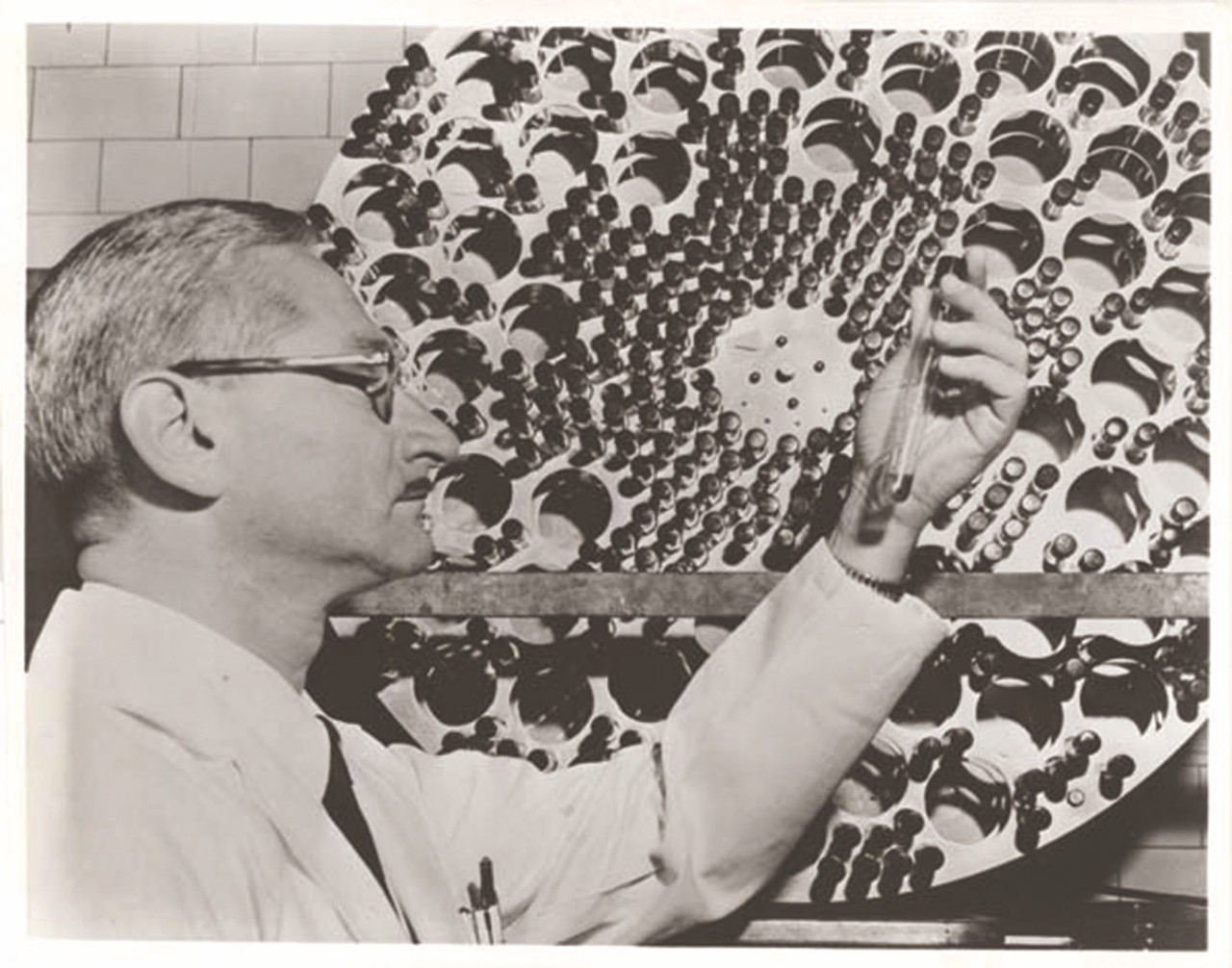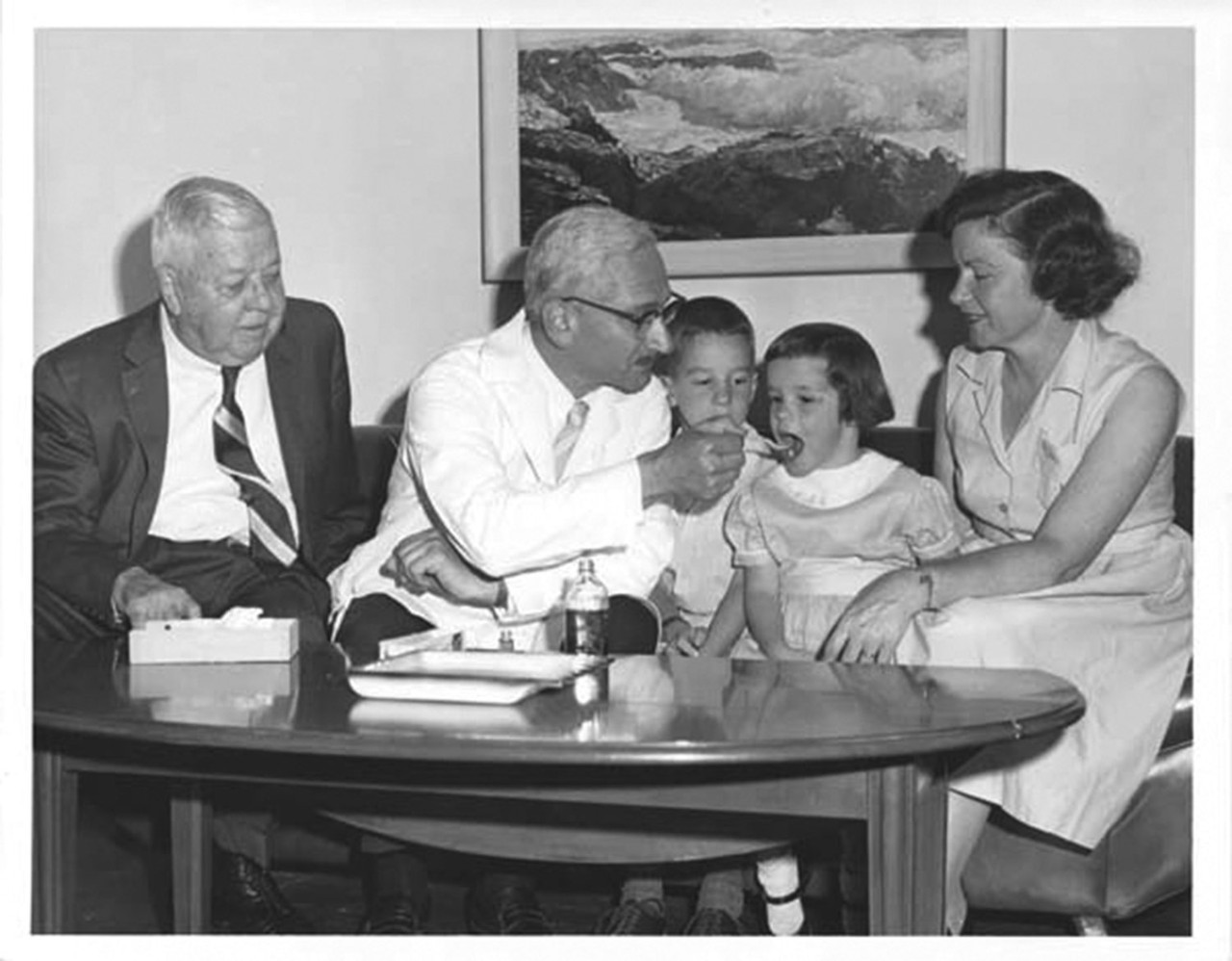UC alumnus contributes to long, winding path of FDA approval for maribavir
On Oct. 7, 2021, John Drach sat at his computer in his Northern Kentucky home to watch a live stream of a bureaucratic government meeting. While the average person may have been bored by the proceeding, Drach was on the edge of his seat.
It was a Food and Drug Administration advisory panel meeting, and the panel was voting on whether to recommend that the FDA approve a new drug to treat infections stemming from a common virus similar to those that cause chickenpox, herpes simplex and mononucleosis, called cytomegalovirus (CMV). Drach, a University of Cincinnati alumnus, had helped develop the drug nearly three decades earlier.
When the panel voted 17-0 in favor of approval, Drach “just about jumped out of my chair.”
The FDA formally approved the drug, called maribavir, about a month later, meaning Drach and his colleagues’ work had finally paid off and been recognized and would be able to help patients in need when other treatments had failed them.
Drug development is rarely a smooth path, but maribavir’s path to approval was filled with many setbacks, twists and turns. The University of Cincinnati is continuing to prepare students for careers in drug development, and Drach’s story serves as a lesson of the persistence needed in the field.
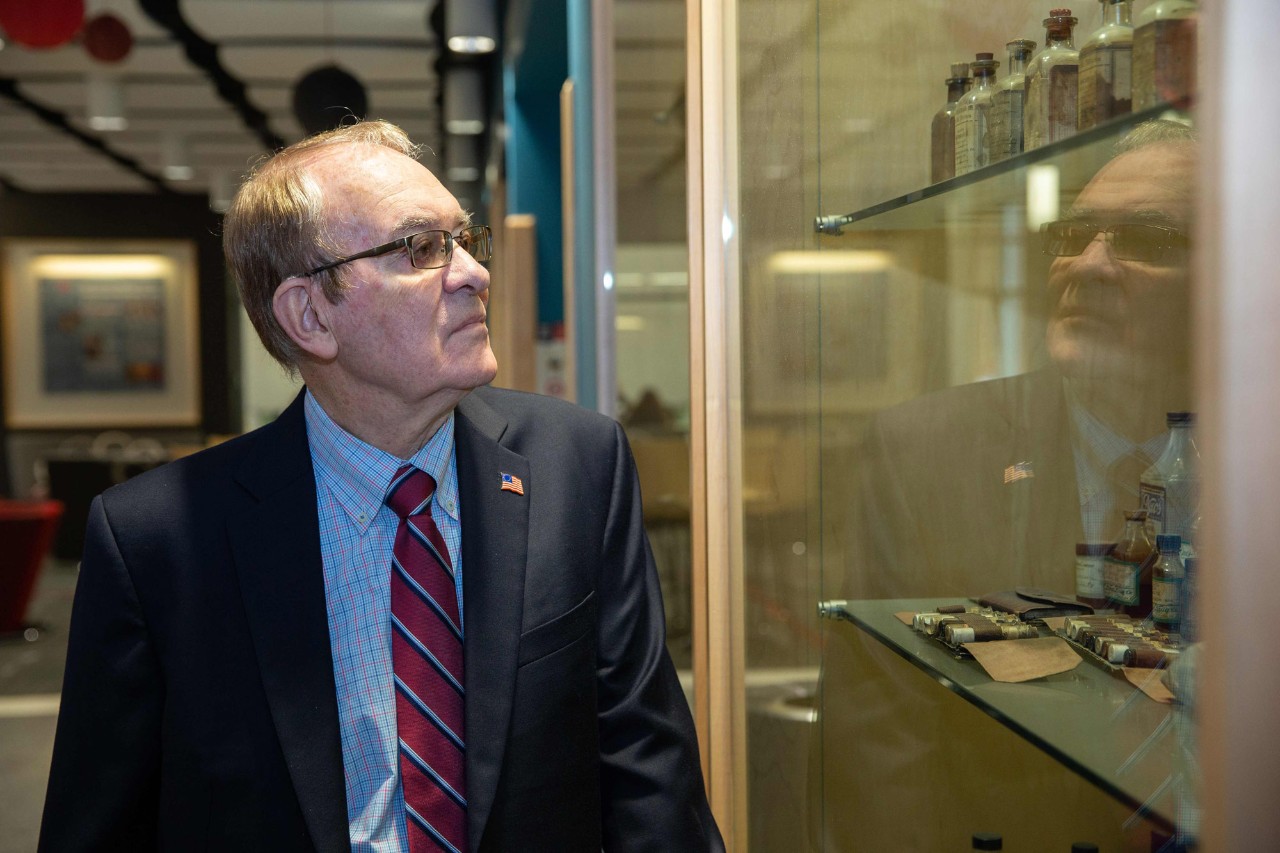
John Drach has made his mark in the history of pharmacy, helping develop the drug maribavir to treat cytomegalovirus. Photo/Andrew Higley/University of Cincinnati.
Timeline
1957: Drach enrolls for undergrad at UC.
1966: Drach graduates with his PhD from the UC College of Medicine.
1970: Drach begins job as professor at University of Michigan.
1984: Drach and team begin testing compounds to treat CMV.
1995: Phase 1 trials show maribavir is nontoxic, but it's then put on the shelf following a pharmaceutical company merger.
2000: ViroPharma licenses the drug for further use, and arbitration process confirms Drach as a co-inventor on the patents.
2021: Takeda completes Phase 3 trials; FDA approves maribavir.
Undergrad experience
Drach grew up in Bellevue, Kentucky, and began working behind the soda fountain in his father’s drugstore in Dayton, Kentucky, the summer after sixth grade. When it was time for college in the fall of 1957, Drach enrolled at UC and majored in engineering at first, but he quickly realized he wasn’t interested.
With his experience working in nearly every capacity at the drugstore, and an interest in science, Drach opted to instead pursue pharmacy. The dean of the College of Pharmacy at the time, Joseph F. Kowalewski, had taught Drach’s father when he went to pharmacy school and later became the namesake for Kowalewski Hall, where the College of Pharmacy resides today on UC’s medical campus.
While it was a four-year Bachelor of Science degree track and not an advanced degree like today, Drach said the pharmacy program was demanding. The program entailed taking about as many chemistry and biology courses as chemistry and biology majors did, with the added professional pharmacy courses, he said.
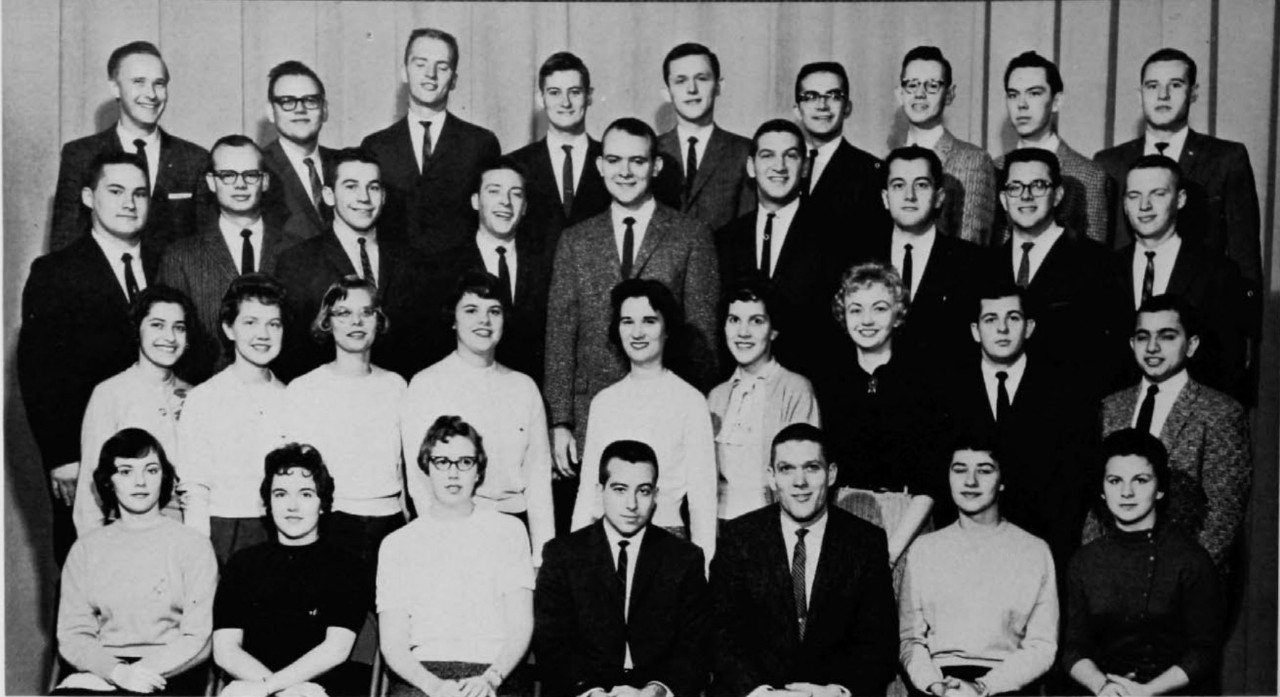
The 1961 edition of the University of Cincinnati yearbook The Cincinnatian displays student members of the American Pharmaceutical Association. John Drach is pictured in the center of the third row, while his future wife Jeanne Flamm is pictured fourth from the right in the second row.
“With the exception of a lunch break and a half-hour break in the morning twice a week, we had classes or labs pretty much from 8 a.m. until 5 p.m. That did not include time to study,” he said. “And in addition to it, some of us worked in drugstores for a few hours throughout the week. So my recollection of UC as an undergrad as a pharmacy major was just busy, busy, busy.”
Outside the classroom, some of Drach’s fondest memories are attending nearly every home men’s basketball game that Bearcat great Oscar Robertson played at Armory Fieldhouse and the Bearcats’ upset of a powerful Ohio State team for the 1961 national championship. But the biggest highlight of his college career was meeting his future wife Jeanne Flamm, a fellow pharmacy student. The Drachs were married for more than 50 years before her passing in 2015.
Growth in research
During his undergraduate career, Drach said he determined he did not want to pursue retail pharmacy like his father since he had grown up in that environment. He was also encouraged to pursue research activities by a professor, Gilbert Schmidt.
After graduating with his bachelor’s in 1961, Drach decided to stay at UC under Schmidt’s mentorship to pursue his master’s degree in pharmaceutical chemistry. He stayed on to earn his doctorate in biochemistry through the College of Medicine in 1966 under the mentorship of Jerry Lingrel, who was conducting cutting-edge research on messenger RNA.
In 1966, Drach accepted a job at Parke-Davis Pharmaceuticals in Ann Arbor, Michigan, in the drug metabolism group, eventually taking a special interest in antiviral drugs.
“We got to interact with all sorts of different people in terms of drug discovery, with chemists, with physiologists, pharmacologists and toxicologists,” Drach said. “So I got a pretty good idea of what drug development was all about.”
A few years later, Drach got a call out of the blue from the University of Michigan asking if he’d be interested in applying for an assistant professorship, with a joint appointment in the College of Pharmacy and School of Dentistry. He applied, was hired in 1970 and brought his focus on antiviral drugs and biochemistry back into the world of academia.
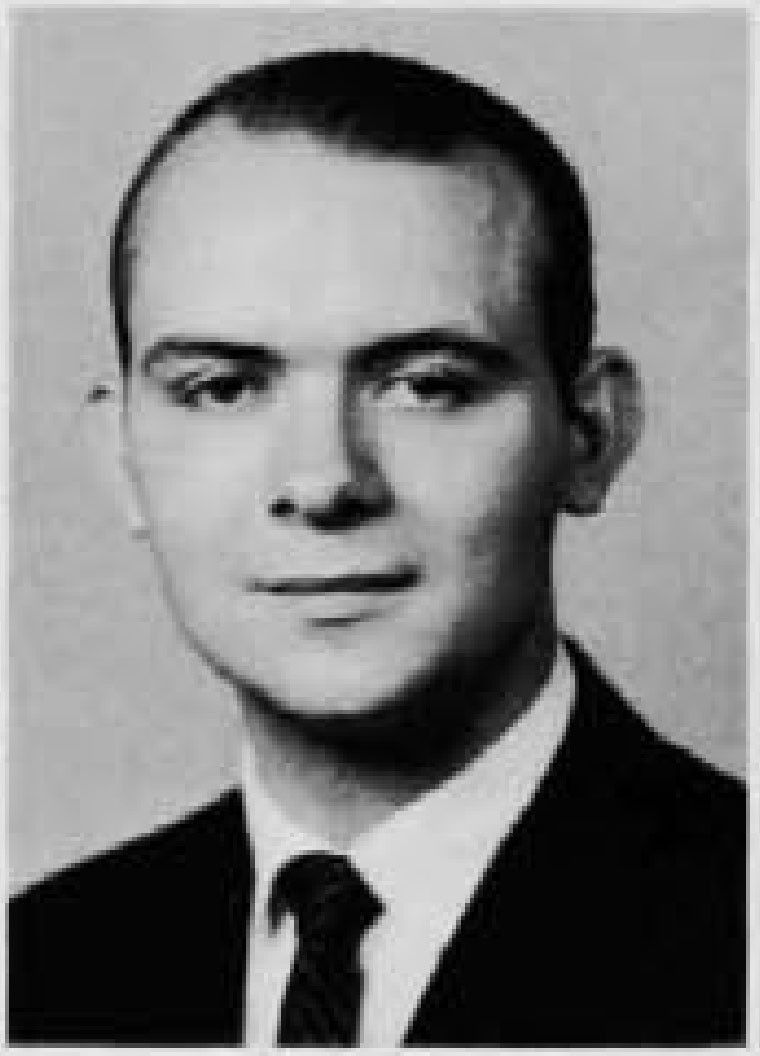
John Drach's yearbook photo in the 1961 edition of The Cincinnatian.
While his expertise was in pharmacy and biochemistry, the joint appointment allowed Drach to become a part of a new basic science department in the School of Dentistry. He started working closely with virologist Charles Shipman, from whom he learned cell culture and virology.
Several years later, when renowned chemist Leroy Townsend was recruited to Michigan to head the Medicinal Chemistry Program in the College of Pharmacy, Drach began to collaborate with him.
“Leroy had a huge reputation already as someone who made compounds as potential anticancer and antiparasitic drugs,” Drach said. “Over the next year or so, he and I did a lot of talking and decided that we ought to take a look at some of his compounds for antiviral activities. And so that initiated a collaboration that was very fulfilling for both of us.”
Together, Drach estimated he and Townsend published more than 100 papers and were co-inventors on at least 50 patents in nearly 30 years of collaboration.
Targeting CMV
Because they were appointed in the School of Dentistry, some of Drach, Shipman and their colleagues’ work focused on oral health, which led to them working on treatments for herpes viruses. Around 1984, the National Institute of Allergy and Infectious Diseases (NIAID) put out a request for proposals for the development of a new drug to treat CMV infections, one of seven human herpes viruses.
Drach said like other herpes strains, CMV can lay dormant for life once it infects a patient. A very large percentage of people are infected, usually in childhood. The virus can cause fatigue and a low-grade fever when first infecting a person and is typically not a problem when dormant, but for people who are immunocompromised, it can be life-threatening.
“Cytomegalovirus will infect just about any organ in the body,” Drach said. “It will infect the intestinal tract, it will infect the brain. The blasted virus can infect your bone marrow and kill you, or infect your eye, and if there were no treatment available it would cause blindness.”
Drach said the team knew little about CMV, but they quickly learned and began testing compounds that the University of Michigan’s Townsend group had previously synthesized. They were then awarded a contract from NIAID, becoming one of three funded sites working to develop a new CMV drug in the U.S. at the time.
Some of the early compounds the team tested were previously developed by Townsend as successful anticancer drugs, but they were found to be too toxic when treating CMV.
“For an antiviral drug, you have to find a compound that will stop the replication of the virus without killing uninfected cells. And that was the big trick,” Drach said, because viruses use much of the infected cells’ “machinery” to replicate.
Drach then had the idea to test Townsend’s compounds that had failed as anticancer drugs because they had little toxicity to cancer cells. The team did find several compounds that successfully stopped CMV from replicating while being nontoxic.
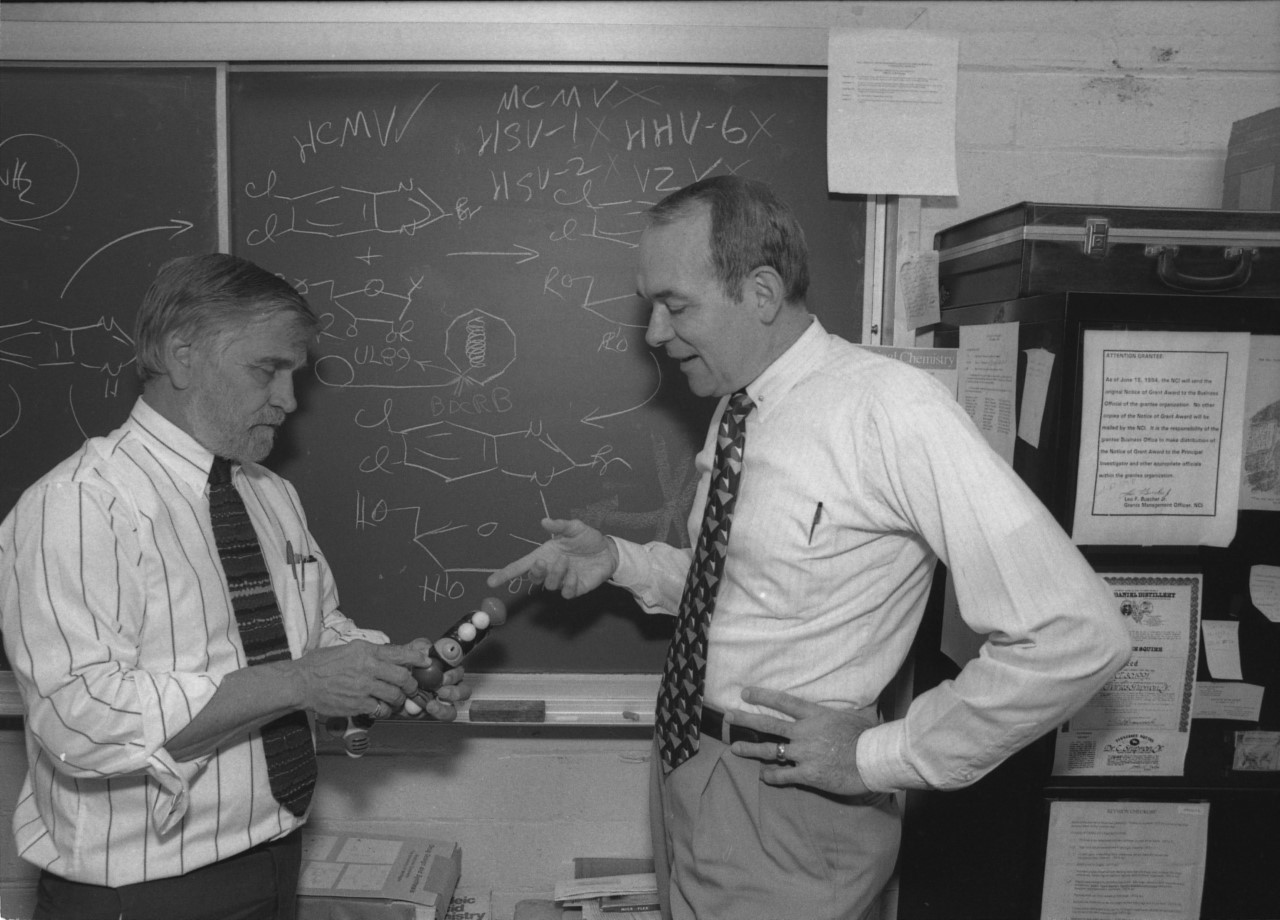
Leroy Townsend, left, and John Drach, right, discuss the identification of the active compound that targets CMV with diagrams of how the compound was synthesized and its unique properties displayed on the chalk board behind them in 1995. Photo of John Drach and Leroy Townsend, 1995; courtesy of BL025287, Folder 12625, Box C89, News and Information Services Photographs, Bentley Historical Library, University of Michigan.
To move the research forward, expertise in drug development beyond that in Townsend’s chemistry and Drach’s biochemistry and virology labs was needed. Typically this included toxicology studies and drug absorption and metabolism analyses. At that time, these capabilities were found primarily in the pharmaceutical industry.
Based upon the contact provided by their project officer at NIAID, Karen Biron of Burroughs Wellcome Co. (BW) was excited to learn of their work and invited Drach and Townsend to present their studies to scientists at BW. The company was very interested in their technology and the series of compounds that were active against CMV. Licensing agreements between BW and the University of Michigan were reached so the necessary drug development could continue.
The best compound from Townsend’s lab was not toxic in animals but unfortunately was metabolized too rapidly to be an effective drug. Many new collaborative studies between the Michigan and BW scientists led to a few new compounds that were active against the virus, not toxic in animals and were not rapidly metabolized.
One of these compounds, maribavir, was chosen by BW for development to treat human CMV infections. The collaboration served as an excellent example of how interdisciplinary research can put a compound on the path to a new drug, but there would be a long journey before FDA approval.
— John Drach, PhD
Mergers and patent disputes
By 1995, BW conducted Phase 1 clinical trials of maribavir that proved the drug was nontoxic in humans, with the worst side effect reported being an unpleasant aftertaste.
Drach estimated maribavir could have been approved by the FDA before 2000, but progress was halted when BW merged with the Glaxo Corp. to become Glaxo Wellcome. As the new company decided which drugs to prioritize, maribavir was “put on a shelf,” and stayed there when the company was again bought out to become GlaxoSmithKline (GSK).
While the merging pharmaceutical companies put development on hold, Townsend’s group continued to make new drugs while Drach, Biron and their groups continued to research how maribavir and related compounds worked. Remarkably, although chemically similar to another compound, maribavir was found to inhibit CMV by a totally different mechanism.
“We discovered that maribavir had a very unique mechanism of action, one never before seen in an antiviral drug,” Drach said. The group also made interesting discoveries about how certain viral genes act to reproduce the virus.
Eventually, a company called ViroPharma was interested in licensing maribavir from GSK around the year 2000. While ensuring that the patents were in good order, it was found that Drach and Townsend were not listed as co-inventors, even though their ideas and efforts directly led to the drug’s discovery.
The issue of ownership of the patents went through an arbitration process, agreed to by GSK and the University of Michigan. Drach credited “divine guidance or pure dumb luck” in assisting being recognized for their contributions.
“One Saturday afternoon, [Townsend] was straightening out things in his office and found certain presentation materials that absolutely established that he and I had discussed compounds like maribavir before we ever met people at the pharmaceutical companies,” he said.
The arbitrator said Townsend was a co-inventor on four relevant patents, with Drach credited as co-inventor on three patents.
“So that’s why I can claim myself as a co-inventor on maribavir,” Drach said. “So essentially, two Davids took on Goliath and we won. It’s pretty remarkable.”
Crossing the finish line
With the patent issue resolved, ViroPharma launched a Phase 2 clinical trial that showed promising results, but a Phase 3 trial showed the drug was safe but was not particularly effective. Drach believes they made a mistake in this phase by dosing the drug several times lower than what had proven safe in previous trials, making it not potent enough to prevent CMV replication.
ViroPharma began a new Phase 3 trial, but in an endless cycle of company mergers, it was then acquired by Shire, who continued the new set of Phase 3 trials. Shire then merged with a Japanese company, Takeda.
“I thought, ‘Oh my gosh, nothing will ever happen,’” Drach said. “Well, to their credit, Takeda has taken the drug forward. They finished Phase 3 clinical trials.”
Takeda’s clinical trials proved what Drach, Townsend, Biron and others had thought for years: maribavir was safe and effective when given to patients at appropriate dosages.
— Pankaj Desai, PhD
After more than 30 years, Takeda’s licensing of the drug was approved by the FDA late last year. It is sold under the brand name “Livtencity” by Takeda.
“I look back on it, and it really is an incredible story,” Drach said.
Despite the setbacks along the way, Drach said the approval still shows the importance of cooperation among government, academic and industry partners to develop new drugs.
Pankaj Desai, PhD, director of UC’s James L. Winkle College of Pharmacy drug development graduate program, said often researchers like Drach contribute years of study to a drug without reaching the finish line of FDA approval.
“They all contributed to being there, but a lot of times our efforts don’t translate into that success,” he said. “The name of the game is persistence and perseverance.”
Looking ahead
The current FDA approval for maribavir states it can be administered for CMV patients who have been treated with other antiviral drugs that have failed. Drach predicts the drug’s effectiveness will eventually lead it to become the preferred CMV treatment as Takeda continues new trials of different indications and dosages for the drug.
“I think this is just the start of the use of the drug,” he said.
While the continuous mergers and decisions from pharmaceutical companies slowed maribavir being approved, Drach said the story of its approval reiterates the reality that companies must have a financial interest to move forward a drug’s development. He noted Alexander Fleming had developed penicillin in 1928 with the thought that he would keep it patent-free and available to everyone, but it did not pick up steam until World War II when patents were issued to develop the drug further.
UC’s proud history of creating medicine, saving lives
The Cincinnati College of Pharmacy (now UC’s James L. Winkle College of Pharmacy) was the first pharmacy college established west of the Allegheny Mountains in 1850.
UC alumnus and chemical engineering professor George Rieveschl developed Benadryl, the first popular antihistamine, in the 1940s.
UC medical researcher Albert Sabin developed the first oral polio vaccine in the 1950s, saving untold millions around the world from paralytic polio and death.
UC alumnus George Sperti is credited with inventing Aspercreme for arthritis relief, Preparation H and the sun lamp and also held numerous patents in selective radiation used to create vitamins, kill bacteria and preserve foods such as orange juice in frozen concentrate.
UC's Albert Sabin developed the world's first oral polio vaccine. Photo/UC Archives
Drug development at UC
The University of Cincinnati’s James L. Winkle College of Pharmacy continues to train students in the area of drug development. UC’s Desai said at least 50 former UC students have played a part in contributing to the discovery and development of new drugs that are now on the market.
“Some of my own students have worked at companies such as Pfizer, Sanofi, AstraZeneca, Merck, Genentech and several other small biopharmaceutical companies,” said Desai, professor and chair of the UC College of Pharmacy’s Pharmaceutical Sciences Division. “I can think of at least three or four other alumni who played the kind of important role as Drach did in the successful launch of other drugs.”
Desai launched the drug development graduate program in 2004 after perceiving a gap in the U.S. pharmacy education system. The drug development program is open to a wide range of medical professionals including nurses, pharmacists, doctors and researchers with degrees ranging from bachelor’s to doctorates or medical degrees.
“The program addresses how drugs are discovered, how the drugs are developed during the preclinical phases and then how do you take those one or two gems from preclinical, move to the clinical realm and go for the full development,” he said. “It takes almost 10,000-plus molecules to discover and initially research to make one drug molecule.”
Program growth
Desai said about 200 students have graduated from the program over the years, and he is particularly proud of the fact that the program has been successful in recruiting and training women and underrepresented student populations.
“I would like to think that each and every individual who graduated has gained tangibly something in terms of a promotion at their own company or a better job opportunity somewhere,” he said.
In addition to the graduate degree pathway, the program has grown to also include two graduate certificate programs in global regulatory affairs and clinical trials, design and research for professionals looking to gain knowledge in a more specific area to meet their needs.
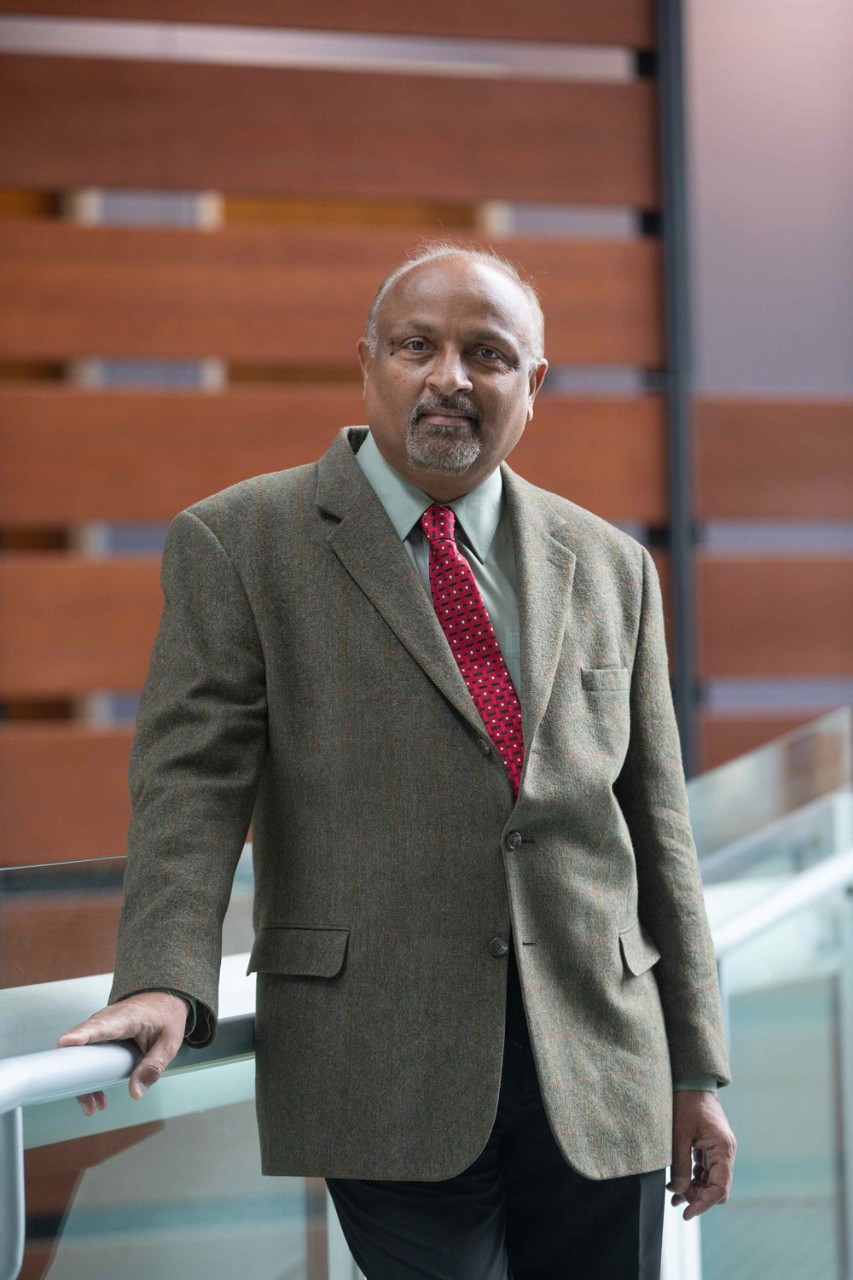
Pankaj Desai, PhD. Photo/Andrew Higley/University of Cincinnati
Since the program was geared for working professionals, it began as primarily scheduled during evening hours. In fall 2020, Desai worked closely with UC Online to transition the onsite/hybrid program to be fully online, opening up more opportunities for students. With the help of UC Online colleagues, the program has quadrupled and enhanced its national and international outreach.
“We now have this year an enrollment of around 50-55 students,” he said. “We’re getting applicants from Singapore and Brazil and places like that, so I think that provides us additional opportunities for global outreach.”
Just as Drach had a team of mentors along the way in his career, Desai said the success of the program lies in the strength of the approximately 30 faculty members who teach and mentor students. He noted the majority of the faculty who helped get the program off the ground nearly 20 years ago are still actively involved.
“I think it’s a good example of a pragmatic curriculum one can develop and deliver,” Desai said. “I think if you take any of the companies regionally, and probably internationally now, you will find graduates of our program.”
The academic difference
Drach’s position at the University of Michigan gave him and his colleagues the freedom to pursue areas that interested them, including testing former anticancer drugs as a treatment for CMV. Desai said academic drug development researchers are uniquely qualified to look at the big picture and find innovative new solutions, all the while training the next generation.
“Individuals working in the industry are essentially focused on niche areas, pigeonholed if you want to put it that way,” Desai said. “But here, we can take a much more global view of the process and bring new perspectives. We do basic, translational and clinical research, we have deep expertise in these areas, and we know how to teach, mentor and work with students.”
Today, researchers at the College of Pharmacy are primarily focused on developing drugs for cancer and neurological conditions, as well as biomembrane drugs that need to travel across membranes like the skin, gastrointestinal lining or the eye to reach their intended target.
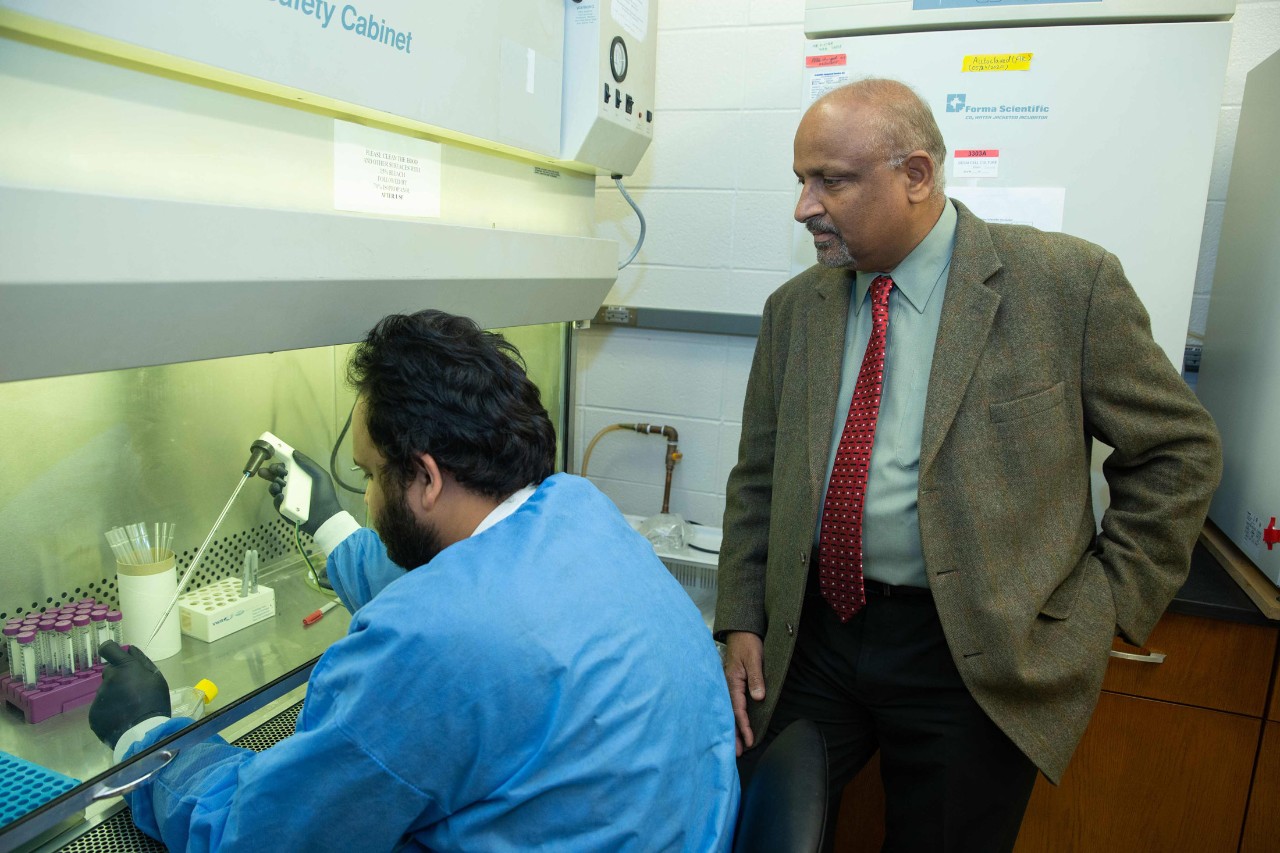
Researchers at the College of Pharmacy primarily focus on developing drugs to treat cancer and neurological conditions. Photo/Andrew Higley/University of Cincinnati.
Desai’s lab is currently studying neurooncology drugs, specifically researching if a drug called letrozole that was found to be effective as a breast cancer treatment can be used to treat aggressive brain tumors called glioblastomas (GBM). The team is working through Phase 1 clinical trials and obtaining a “method of use” patent, or one that is issued when an inventor has discovered a way to use either a patented drug or an unpatentable (generic) drug in a “novel, useful and non-obvious” way. The result is a medical procedure that is unique not because of the drug, but because of the way that the drug is administered.
“We are hoping that that drug becomes a part of the armament against fighting a very deadly disease, the GBM,” Desai said. “It’s probably one of the most complex diseases. Most compounds don’t eventually work out, but this is a proven compound in breast cancer. It has a lot of safety data, and again we hope it survives the test of time.”
Perhaps someday soon, Desai and his colleagues will be on the edge of their seats watching an FDA advisory panel meeting, adding the next chapter of UC faculty, students and alumni making contributions in the world of drug development.
Editor's Note: This story has been updated to more accurately reflect the foundational role of George Rieveschl in developing Benadryl.
Featured image at top: archive image of Townsend and Drach courtesy of the University of Michigan; photo of Drach and Desai by Andrew Higley/UC Creative + Brand.
Digital design by Kerry Overstake.
Related Stories
UC Honors students gain hands-on research experience
April 1, 2025
The Biomedical Research and Mentoring Program is open to any University Honors Program students. The faculty mentors are typically from UC’s College of Medicine or Cincinnati Children's Hospital.
UC doctor patenting first at-home endometriosis diagnostic test
March 31, 2025
March is endometriosis awareness month. Endometriosis is a condition that can be debilitating and is estimated to affect more than 6 million women in the U.S. Endometriosis occurs when tissue similar to the lining of the uterus grows outside of the uterus, causing pain, inflammation and potential infertility. The road to a diagnosis has been challenging for many women, but a University of Cincinnati researcher has developed a noninvasive diagnostic test that could make a difference.
Cancer Center, Dana-Farber, more receive $1.2M from family...
March 28, 2025
The Cincinnati Business Courier highlighted a $1.2 million grant received by the University of Cincinnati Cancer Center's Timothy Phoenix and colleagues at Dana-Farber Cancer Institute and the German Cancer Research Center to study pediatric low-grade gliomas.
UC welcomes new engineering faculty
March 28, 2025
UC welcomes three new faculty this spring in mechanical engineering, aerospace engineering and a new department head in engineering education.
New AI tools available to UC students, faculty and staff
March 27, 2025
The University of Cincinnati recently added additional resources to its suite of supported AI tools for students, faculty, and staff.
Kentucky mom shares her colon cancer journey to save others
March 26, 2025
University of Cincinnati Cancer Center patient Patty Goering and physician researcher Tahir Latif spoke with WLWT about Goering's story of being diagnosed and treated for colon cancer at a young age.

